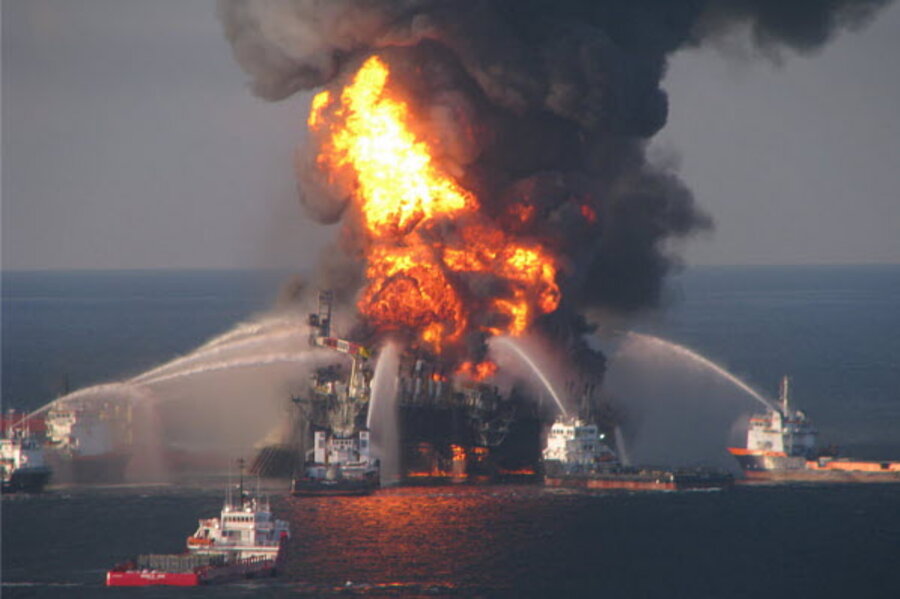Gulf oil spill: Halliburton to plead guilty to destroying spill evidence
Loading...
| NEW ORLEANS
Halliburton Energy Services has agreed to plead guilty to destroying evidence in connection with the 2010 Gulf oil spill, the Department of Justice said Thursday.
Federal officials said in a news release that a criminal information charging Halliburton with one count of destruction of evidence was filed in federal court in Louisiana.
Halliburton has agreed to pay the maximum fine, be on probation for three years and continue to cooperate with the government's criminal investigation, according to the news release, which did not list the amount of the fine.
The Houston-based company has also made a $55 million voluntary contribution to the National Fish and Wildlife Foundation. It was not a condition of the court agreement, the news release says.
The company said in a statement Thursday night that it had agreed to plead guilty "to one misdemeanor violation associated with the deletion of records created after the Macondo well incident, to pay the statutory maximum fine of $200,000 and to accept a term of three years probation."
The Justice Department has agreed it will not pursue further criminal prosecution of the company or its subsidiaries for any conduct arising from the 2010 spill, Halliburton's statement said, adding that federal officials have also "acknowledged the company's significant and valuable cooperation during the course of its investigation."
The plea agreement is subject to court approval, the company said.
Halliburton was BP's cement contractor on the drilling rig that exploded in the Gulf of Mexico in 2010. The blowout triggered an explosion that killed 11 workers and spilled millions of gallons of oil into the Gulf.
According to the news release, Halliburton conducted its own review of the well's design and construction after the blowout, and established a working group to review "whether the number of centralizers used on the final production casing could have contributed to the blowout."
The casing is a steel pipe placed in a well to maintain its integrity.
Centralizers are metal collars attached on the outside of the casing. Centralizers can help keep the casing centered in the wellbore.
"Centralization can be significant to the quality of subsequent cementing around the bottom of the casing," the news release said.
Prior to the blowout, Halliburton had recommended to BP the use of 21 centralizers in the well, but BP decided to use six instead, the news release says.
Around May 2010, the news release says, the company directed a program manager to conduct two computer simulations of the Macondo well final cementing job "to compare the impact of using six versus 21 centralizers."
The simulations indicated there was little difference between using six and 21 centralizers, but the program manager "was directed to, and did, destroy these results," federal officials say.
Similar evidence was destroyed in a subsequent incident, in June 2010, the Justice Department said.
"Efforts to forensically recover the original destroyed Displace 3D computer simulations during ensuing civil litigation and federal criminal investigation by the Deepwater Horizon Task Force were unsuccessful," the news release said. "In agreeing to plead guilty, Halliburton has accepted criminal responsibility for destroying the aforementioned evidence."
In December 2011, BP asked a judge to sanction Halliburton for its handling of cement testing and Displace 3D modeling results. Halliburton claimed that its modeling results were "gone" and couldn't be found, an explanation that BP attorneys said was "at a minimum, highly suspicious."
"Purposefully destroying evidence because it is deemed to contain potentially unfavorable information that could benefit a litigation adversary is, by definition, 'bad faith' conduct," they wrote in a court filing.
The plea agreement and criminal charge both arise from a criminal investigation by the Deepwater Horizon Task Force into the spill.
U.S. District Judge Carl Barbier in New Orleans recently presided over a trial in the matter and could decide how much more money BP, Halliburton and rig owner Transocean Ltd. owe for their roles in the catastrophe.
Halliburton and BP have blamed each other for the failure of the cement job to seal the Macondo well.
During the spring trial, BP asked a federal judge to sanction Halliburton for allegedly destroying evidence about the role that its cement slurry design could have played in the blowout.
After the trial started on Feb. 25, Halliburton discovered cement samples at a Lafayette laboratory that weren't turned over to the Justice Department for testing after the spill. Halliburton lawyers called it a "simple misunderstanding" and accused BP of trying to create a "sideshow."
Halliburton announced in April that it was trying to negotiate a settlement to resolve a substantial portion of private claims it has faced since the Deepwater Horizon rig blast spawned America's worst offshore oil spill.







